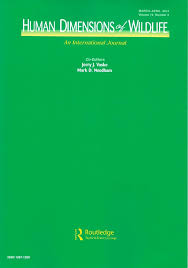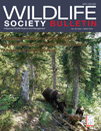Two related but importantly different ideas underpin the public trust in wildlife: public trust thinking and the public trust doctrine.
These ideas are central because public trust thinking and the public trust doctrine provide much of the philosophical and legal basis for managing wildlife. An entire institution has evolved over many years that governs how wildlife management decisions are made and implemented.
Public trust thinking is a philosophy that emphasizes concepts of trusteeship to frame responsibilities for conserving wildlife resources for the benefit of current and future generations, without privileging particular individuals or groups. It holds that certain resources are not suitable for exclusive private ownership and it is the government’s responsibility to manage these resources as an endowment of natural wealth in perpetuity. 1 2 Public trust thinking inspires federal and state wildlife law and policy in the U.S. Although decisions about wildlife are made at various spatial and jurisdictional levels in the U.S., and management practices vary across these levels, the same fundamental principles apply. 3 4 5 6 7 8
The public trust doctrine is a common law legal framework derived from a Supreme Court Decision (Martin v. Waddell 1842) that formally incorporates aspects of public trust thinking. This doctrine has been incorporated into statutory and common law at the state level to varying degrees. 9 10
Essential elements of the public trust in wildlife are:
Trust assets: Wildlife resources that provide benefits for current and future generations. 11 12 13 To be considered trust resources owned by government, wildlife have legal status as property.
Benefits: Positive outcomes derived from trust assets and their management. These outcomes may be social, psychological, economic, recreational, health- and safety-related, or cultural. 14 15 Note, these may include a reduction of negative impacts from wildlife or management of wildlife.
Beneficiary: Any person who receives a benefit from wildlife or the conservation of wildlife. Beneficiaries include those who are unaware of the benefits they receive, as well as future generations. Beneficiaries hold trustees accountable in courts and elections. 16 17 18 19 20 21
Trustees: Elected and appointed government officials legally responsible for policy-level decisions regarding public trust wildlife resources. The most prominent trustees are state legislators and appointed wildlife commissioners who make wildlife statutes or rules, respectively. 22 23 24 Ancillary trustees include federal government officials (such as for federally listed species), and water and land managers in state and local government agencies not in the wildlife management agency. Trustees are accountable to beneficiaries.
Trust managers: The professional staff employed by public wildlife agencies responsible for day-to-day management of trust resources, for example developing management options, analyzing trade-offs, and making recommendations to trustees. Trust managers may in some instances include partner organizations that have been given approval to manage trust resources, with oversight from the wildlife agency. Trust managers are directly accountable to trustees, and indirectly accountable to beneficiaries.
Trust administrators: Trustees and trust managers collectively. 25 26
Back to the Public Trust Anthology main page
Featured Publications
Click on the image to be directed to the article website. Placing your cursor on the text will automatically stop the movement.
- Principles of Public Trust Thinking ↩
- Governance Principles for Wildlife Conservation in the 21st Century ↩
- Stakeholders as Beneficiaries of Wildlife Management ↩
- Challenges for Multilevel Stakeholder Engagement in Public Trust Resource Governance ↩
- Designing Regional-level Stakeholder Engagement Processes: Striving for Good Governance while Meeting the Challenges of Scale ↩
- The Role of State Wildlife Professionals under the Public Trust Doctrine ↩
- Applying Public Trust Thinking to Wildlife Governance in the United States: Challenges and Solutions ↩
- What Does it Mean to Manage Wildlife as if Public Trust Really Matters? ↩
- Impacts Management: An Approach to Fulfilling Public Trust Responsibilities of Wildlife Agencies ↩
- The Public Trust Foundation of the North American Model of Wildlife Conservation ↩
- Wildlife Health and Public Trust Responsibilities ↩
- Applying Public Trust Thinking to Wildlife Governance in the United States: Challenges and Solutions ↩
- Public Trust Principles and Trust Administration Functions in the North American Model of Wildlife Conservation: Contributions of Human Dimensions Research ↩
- Impacts Management: An Approach to Fulfilling Public Trust Responsibilities of Wildlife Agencies ↩
- Stakeholders as Beneficiaries of Wildlife Management ↩
- Principles of Public Trust Thinking ↩
- Stakeholders as Beneficiaries of Wildlife Management ↩
- Stakeholder Engagement in Wildlife Management: Does the Public Trust Doctrine Imply Limits? ↩
- Challenges for Multilevel Stakeholder Engagement in Public Trust Resource Governance ↩
- Impacts Management: An Approach to Fulfilling Public Trust Responsibilities of Wildlife Agencies ↩
- Applying Public Trust Thinking to Wildlife Governance in the United States: Challenges and Solutions ↩
- The Role of State Wildlife Professionals under the Public Trust Doctrine ↩
- Applying Public Trust Thinking to Wildlife Governance in the United States: Challenges and Solutions ↩
- Public Trust Principles and Trust Administration Functions in the North American Model of Wildlife Conservation: Contributions of Human Dimensions Research ↩
- The Role of State Wildlife Professionals under the Public Trust Doctrine ↩
- Applying Public Trust Thinking to Wildlife Governance in the United States: Challenges and Solutions ↩


